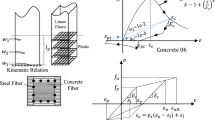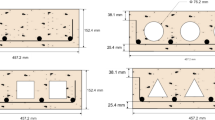Abstract
This article presents the results of experimental research on the behaviour of deep cement mixing (DCM) walls during excavation up to failure. For this purpose, a novel laminar box equipped with a set of springs and a pneumatic loading system were designed and developed to run a total of nine scaled-down model tests at normal gravity on five different testing programs: (1) the wall thickness variation, (2) wall modulus variation, (3) effect of the reinforcement, (4) the bending stiffness (EI) control, and (5) the wall volume control of varying wall slenderness. The responses of the walls were studied through the wall horizontal displacement profile, tensile strains along with wall depth on the retained side, the distribution of strains using photogrammetric analysis and observation of crack initiation at the wall. The experimental results indicate that the behaviours of DCM walls depend strongly on the wall dimensions, particularly the thickness, and the analysis concepts used for conventional retaining walls cannot be directly utilized. The wall-to-excavation shape factor has been proven to effectively distinguish the behaviour mode and characterize the crack location concerning the wall height.















Similar content being viewed by others

References
Shao Y, Macari EJ, Cai W. Compound deep soil mixing columns for retaining structures in excavations. J Geotech Geoenviron Eng. 2005;131:1370–7. https://doi.org/10.1061/(ASCE)1090-0241(2005)131:11(1370).
Lindquist D, Upsall B, Horvitz G. Cutter soil mixing excavation and shoring in Seattle’s pioneer square district. In: Earth Retention Conference, 2010, pp. 303–10.
Bahner EW, Naguib AM. Design and construction of a deep soil mix retaining wall. In: Soil Improvement for Big Digs, 1998.
Andromalos KB, Bahner EW. The application of various deep mixing methods for excavation support systems. In: Grouting GR Treatment, 2003.
Gomes AC, Tinoco J, Pinto A, Tomásio R. An anchored retaining wall in CSM. In: 18th International Conference on Soil Mechanics and Geotechnical Engineering, 2013.
Denies N, Huybrechts N. Deep mixing method for the construction of earth and water retaining walls. RILEM Tech Lett. 2017;2:1–9.
Waichita S, Jongpradist P, Jamsawang P. Characterization of deep cement mixing wall behavior using wall-to-excavation shape factor. Tunn Undergr Space Technol. 2019;83:243–53. https://doi.org/10.1016/j.tust.2018.09.033.
Ignat R, Baker S, Larsson S, Liedberg S. Two- and three-dimensional analyses of excavation support with rows of dry deep mixing columns. Comput Geotech. 2015;66:16–30. https://doi.org/10.1016/j.compgeo.2015.01.011.
Ignat R, Baker S, Liedberg S, Larsson S. Behavior of braced excavation supported by panels of deep mixing columns. Can Geotech J. 2016;53:1671–87. https://doi.org/10.1139/cgj-2016-0137.
Briaud J-L, Nicholson P, Lee J. Behavior of full-scale VERT wall in sand. J Geotech Geoenvironmental Eng. 2000;126:808–18. https://doi.org/10.1061/(ASCE)1090-0241(2000)126:9(808).
Mun B, Kim T, Moon T, Oh J. SCM wall in sand: numerical simulation and design implications. Eng Geol. 2012;151:15–23. https://doi.org/10.1016/j.enggeo.2012.09.003.
Waichita S, Jongpradist P, Submaneewong C. Application of ground spring model in excavation supported by deep cement mixing. Int J GEOMATE. 2017;12:30–6. https://doi.org/10.21660/2017.31.6522.
Wyjadłowski M, Puła W, Bauer J. Reliability of diaphragm wall in serviceability limit states. Arch Civil Mech Eng. 2015;15:1129–37. https://doi.org/10.1016/j.acme.2015.02.001.
Bywalski CZ, Kamiński M. Estimation of the bending stiffness of rectangular reinforced concrete beams made of steel fibre reinforced concrete. Arch Civil Mech Eng. 2011;11:553–71. https://doi.org/10.1016/S1644-9665(12)60101-0.
Rutherford CJ, Biscontin G, Briaud JL. Design process of deep soil mixed walls for excavation support. Int J Geoeng Case Hist. 2007;1:56–72.
Fan J, Wang D, Qian D. Soil-cement mixture properties and design considerations for reinforced excavation. J Rock Mech Geotech Eng. 2018;10:791–7. https://doi.org/10.1016/j.jrmge.2018.03.004.
Chore HS, Ingle RK, Sawant VA. Non-linear analysis of pile groups subjected to lateral loads using “p-y” curve. Interact Multiscale Mech. 2012;5:57–73. https://doi.org/10.12989/imm.2012.5.1.057.
Hededal O, Klinkvort R. A new elasto-plastic spring element for cyclic loading of piles using the p-y-curve concept. In: Numerical methods in geotechnical engineering. New York: Taylor and Francis Group; 2010. p. 883–8.
Chaipanna P, Jongpradist P. 3D response analysis of a shield tunnel segmental lining during construction and a parametric study using the ground-spring model. Tunn Undergr Sp Technol. 2019;90:369–82. https://doi.org/10.1016/j.tust.2019.05.015.
Sakamoto T, Katsura Y. A nonlinear soil spring model considering ground stress and strain change during excavation. Int Symp Geotech Asp Undergr Constr Soft Gr. 2012;4:723–8.
Bowles JE. Foundation analysis and design. New York: The McGraw-Hill Companies Inc.; 1996. https://doi.org/10.1016/0013-7952(84)90010-3.
Wood DM. Geotechnical Modelling. London: CRC Press; 2004. https://doi.org/10.4324/9780203477977.
Jongpradist P, Youwai S, Jaturapitakkul C. Effective void ratio for assessing the mechanical properties of cement-clay admixtures at high water content. J Geotech Geoenviron Eng. 2011;137:621–7. https://doi.org/10.1061/(ASCE)GT.1943-5606.0000462.
Kongkitkul W, Tatsuoka F, Hirakawa D. Rate-dependent load-strain behaviour of geogrid arranged in sand under plane strain compression. Soils Found. 2007;47:473–91. https://doi.org/10.3208/sandf.47.473.
Jongpradist P, Tunsakul J, Kongkitkul W, Fadsiri N, Arangelovski G, Youwai S. High internal pressure induced fracture patterns in rock masses surrounding caverns: experimental study using physical model tests. Eng Geol. 2015;197:158–71. https://doi.org/10.1016/j.enggeo.2015.08.024.
Thongraksa A, Punya-in Y, Jongpradist P, Kim HM, Jamsawang P. Failure behaviors of rock masses around highly pressurized cavern: initiation and modes of failure. Tunn Undergr Sp Technol. 2021;115: 104058. https://doi.org/10.1016/j.tust.2021.104058.
Livitsanos G, Shetty N, Verstrynge E, Wevers M, Van Hemelrijck D, Aggelis DG. Numerical simulation of elastic wave propagation in masonry compared with acoustic emission experimental results. Arch Civil Mech Eng. 2020. https://doi.org/10.1007/s43452-020-00019-z.
Jamsawang P, Jamnam S, Jongpradist P, Tanseng P, Horpibulsuk S. Numerical analysis of lateral movements and strut forces in deep cement mixing walls with top-down construction in soft clay. Comput Geotech. 2017;88:174–81. https://doi.org/10.1016/j.compgeo.2017.03.018.
Xu ZH, Wang WD, Wang JH, Shen SL. Performance of deep excavated retaining wall in Shanghai soft deposit. Lowl Technol Int. 2005;7:31–43.
Voottipruex P, Jamsawang P, Sukontasukkul P, Jongpradist P, Horpibulsuk S, Chindaprasirt P. Performances of SDCM and DCM walls under deep excavation in soft clay: field tests and 3D simulations. Soils Found. 2019;59:1728–39. https://doi.org/10.1016/j.sandf.2019.07.012.
Meepon I, Voottipruex P, Jamsawang P. Behaviors of soil cement columns and stiffened soil cement column wall in shallow excavation. Lowl Technol Int. 2016;18:197–208.
Wang JH, Xu ZH, Wang WD. Wall and ground movements due to deep excavations in shanghai soft soils. J Geotech Geoenviron Eng. 2010;136:985–94. https://doi.org/10.1061/(ASCE)GT.1943-5606.0000299.
Xu ZH. Deformation behavior of deep excavations supported by permanent structure in Shanghai Soft Deposit, Shanghai Jiao Tong University. 2007.
Moormann C. Analysis of wall and ground movements due to deep excavations in soft soil based on a new worldwide database. Soils Found. 2004;44:87–98.
Waichita S, Jongpradist P, Schweiger HF. Numerical and experimental investigation of failure of a DCM-wall considering softening behaviour. Comput Geotech. 2020;119: 103380. https://doi.org/10.1016/j.compgeo.2019.103380.
Larsson S, Broms BB. Shear box model tests with lime/cement columns: some observations of failure mechanisms. Int Soc Rock Mech Rock Eng. 2000. https://doi.org/10.1007/s11213-010-9182-4.
Larsson S, Malm R, Charbit B, Ansell A. Finite element modelling of laterally loaded lime-cement columns using a damage plasticity model. Comput Geotech. 2012;44:48–57. https://doi.org/10.1016/j.compgeo.2012.03.004.
Jamsawang P, Voottipruex P, Jongpradist P, Likitlersuang S. Field and three-dimensional finite element investigations of the failure cause and rehabilitation of a composite soil-cement retaining wall. Eng Fail Anal. 2021;127: 105532. https://doi.org/10.1016/j.engfailanal.2021.105532.
Acknowledgements
This research was funded by King Mongkut’s University of Technology Thonburi (KMUTT) and the National Research Council of Thailand (NRCT) under grant No. NRCT5-RSA63006, King Mongkut’s University of Technology North Bangkok under Contract no. KMUTNB-FF-65-38 and the Ratchadapisek Sompoch Endowment Fund (2021), Chulalongkorn University (764002-ENV).
Author information
Authors and Affiliations
Corresponding author
Ethics declarations
Conflict of interest
The authors declare that they have no known competing financial interests or personal relationships that could have appeared to influence the work reported in this paper.
Ethical approval
This article does not contain any studies with human participants or animals performed by any of the authors. It also has not been published by another journal.
Additional information
Publisher's Note
Springer Nature remains neutral with regard to jurisdictional claims in published maps and institutional affiliations.
Rights and permissions
About this article
Cite this article
Waichita, S., Jongpradist, P., Patawanit, P. et al. Deformation and failure mechanism of deep cement mixing walls: experimental study using physical model tests. Archiv.Civ.Mech.Eng 21, 127 (2021). https://doi.org/10.1007/s43452-021-00287-3
Received:
Revised:
Accepted:
Published:
DOI: https://doi.org/10.1007/s43452-021-00287-3



